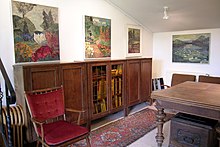Hermann Moog
Hermann Moog (born January 29, 1901 in Gelsenkirchen , † March 24, 1974 in Haltern ) was a German painter and draftsman from Westphalia .
Live and act
Even as a teenager, Hermann Moog strived for an artistic education and began this in 1918 - in addition to his commercial apprenticeship - with evening studies at the Folkwang School in Essen with Professor Urbach. From 1921 he attended the art academy in Düsseldorf . There he studied with Professor August Deusser , who was close to Expressionism .
As early as 1925, Moog's work received great attention on the occasion of an exhibition by the cultural association for art and knowledge in Gelsenkirchen. The friendship and temporary studio community with the painter and art pedagogue Professor Johannes Walter-Kurau in Berlin confirmed his development and led him to final artistic independence.
In 1934, Hermann Moog set up a studio in Holtwick , on the edge of the Hohen Mark near Haltern am See, and painted landscapes based on Rhenish Expressionism , but most of them were destroyed by bombing during the Second World War . In the 1920s and 1930s he exhibited together with Christian Rohlfs and Otto Modersohn as part of the Westphalian Association of Artists .
The war took him to Albania and Russia , from where he brought back motifs, sketches and memories that he incorporated into his later pictures, e.g. B. Sea of Azov (1942), Wanderer Between Worlds (1953). In 1946 he returned from captivity and finally settled in Haltern, where he and his wife Ruth built a house with a studio. In the first years after the war he worked as a commissioned artist and art teacher in high schools, adult education centers and vocational schools and founded Germany's first children's painting school in Marl in 1950 (Malschule Insel ).
In search of new impressions, Hermann Mogg went on “voyages of discovery”. From 1953 he visited Spain , southern France and Italy several times . Many pictures come from this time in which the vastness of the sky and the sea, mostly with boats, are in the foreground. In 1965 he visited Russia and Japan .
In the 1960s and 1970s he devoted himself entirely to painting the nature of the Münsterland surrounding him . “I discover the loneliness in the landscape,” he wrote in his diary. To look at the grown nature and to understand it as existing independently of humans, that became the theme of his life. He recorded many impressions in his sketchbooks or as pencil, fiber pen or charcoal drawings. Also linocuts became a preferred mode of expression. At the age of 73 he died in Haltern.
Exhibitions and estate
From 1925 to 1940, Hermann Moog exhibited, together with other artists from Westphalia and the Rhine-Ruhr area, in Gelsenkirchen, Bochum , Dortmund , Münster , Soest , Düsseldorf and Bielefeld . Solo exhibitions of his pictures and drawings (oil paintings and graphics) took place from 1955, especially in Marl, Recklinghausen , Münster, Wesel , Lembeck and Haltern, especially in his house and studio in Haltern-Holtwick. Hermann Moog confided in his diary: "My painting has become the story of my discoveries." He planned to publish reproductions of his works in a book with the publishing house Bongers, which after his death - according to his plans - by his widow Ruth Moog was issued.
For the more than 40 exhibitions after the death of Hermann Moog, which the artist's nephew (Hermann Moog from Aachen ) designed and supervised, some catalogs with many illustrations have been published. On the occasion of the first exhibition in this episode, the art collector Carl Ridder wrote in the Ruhr-Nachrichten in 1974 :
- "There is hope in his pictures ... Hermann Moog brought something with him that particularly distinguishes Westphalia: the unpathetic way of looking behind things."
Web links
| personal data | |
|---|---|
| SURNAME | Moog, Hermann |
| BRIEF DESCRIPTION | German painter and draftsman |
| DATE OF BIRTH | January 29, 1901 |
| PLACE OF BIRTH | Gelsenkirchen |
| DATE OF DEATH | March 24, 1974 |
| Place of death | Haltern am See |
